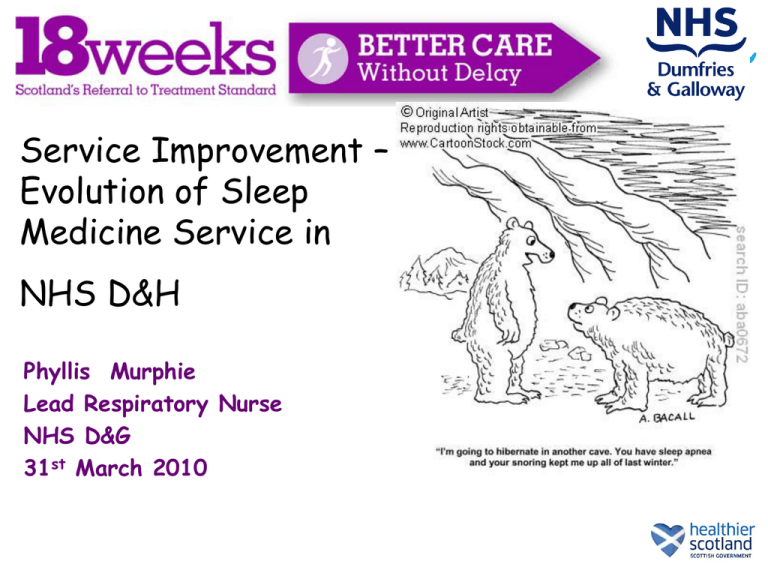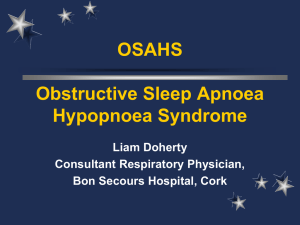V 2 - Quality Improvement Hub
advertisement

Service Improvement – Evolution of Sleep Medicine Service in NHS D&H Phyllis Murphie Lead Respiratory Nurse NHS D&G 31st March 2010 •Service Outline •Background •Referral handling •Booking processes •Reporting •Managing DNAs Service Outline • 430 patients on CPAP therapy • 25 on home NIV therapy. • Predicted annual demand estimated at 80 -100 new patients commencing CPAP therapy and 12 new patients receiving NIV therapy • Ear Nose and Throat department used for in-patient based sleep investigations • Most limited channel studies done as outpatient based service. • > 300 new referrals per year requesting limited channel sleep studies. Obstructive Sleep Apnoea Hypopnoea SyndromeOSAHS • OSAHS – common sleep disorder caused by repetitive upper airway obstruction during sleep – characterized by pauses in breathing during sleep often accompanied by oxygen desaturation Signs/Symptoms of OSAHS • • • • Loud snoring Excessive daytime sleepiness Lack of concentration risk factors for developing OSAHS include increasing age, obesity and being male. • Prevalence - 4% of middle-aged men and 2% of middle-aged women in the UK. Clinical Consequences of OSAHS • 7-14 times more likely to have RTA in OSAHS Service Consequences for OSAHS diagnosis and treatment •Sleep studies •One of diagnostic tests that has referral to treatment standard of 18 weeks •To be achieved by 2011 What have we done in NHS D&G vice Redesign • Clinical teams/18 week teams working together • Innovative ideas to increase the number of outpatient based diagnostic sleep studies. • PDSA - Service redesign projects Referral handling • Respiratory nurse triage of referrals requests • All internal/external requests for sleep study on TOPAZ • Routine/soon (vocational drivers) • Local referral guidelines developed with ENT/Max fax department • Electronic SCI referral being developed (now part of National Scottish Sleep Forum ongoing work plan Booking Processes • Acknowledgment letter regarding referral sent to patient • Requesting they contact secretary to book appointment for sleep study • No response 2 weeks • 2nd letter • No response 2 weeks • Refer back to GP • Remove from W/L Diagnostic service redesign • V 1- 45 minute outpatient appointment on the day of sleep investigation, clinical history, examination, routine bloods – Nurse Led • V 2- 45min - 1hour return appointment day to download and score sleep study and discuss further treatment options /interventions – negative studies discharged back to referrer – Medical Input as requested by RNS • V 2- Positive diagnostic tests for symptomatic OSAHS offered a 1-2 week trial of Auto CPAP • V 3- CPAP proven to be acceptable /effective next review, then supplied with fixed pressure CPAP unit and delivery system • V4 - Reviewed in the Sleep clinic in 3 - 6 months, 1 year, 2 years, Could consider open access review in compliant patients Diagnostic service redesign • Where diagnostic uncertainty, patients reviewed 3-6 months in sleep medicine clinic for further assessment of symptoms • Consideration of repeat limited sleep diagnostic testing may be an option • Referral for full PSG to the Royal Infirmary Edinburgh Sleep Medicine Unit. 2007-2008 Service delivery 250 220 200 208 180 150 Hotel Sleep study Home Sleep study IP sleep study 100 50 50 40 25 15 28 0 2007 2008 2009 15 Reporting of sleep studies • • • • • Service limitation – no physiologist input Development bid 2009- unsuccessful RNS – manually scores sleep studies where indicated Result verified by Physician where indicated More medical input to the service requireddevelopment bid unsuccessful Managing DNA’s • FA x 1 is given for DNA’s • Letter sent to patient and copy to GP re DNA in case of postal issue • DNA rate usually low as patient focused booking with Respiratory secretary. • DNA’s in Sleep medicine clinics – same as above. Patient Satisfaction with service • Questionnaire of patient’s views of service delivery • Demonstrated overall satisfaction with service provision and a preference for home based testing where possible • Number of failed/repeat tests are minimal Current service limitations • People from West of region have to travel to Dumfries for IP/Hotel based sleep study – 150 mile round trip • No respiratory physiology staff input into scoring of sleep studies • Follow-up needs of the increasing numbers on CPAP is now limiting our ability to carry out new assessments. • Demand for service now greater that Medical/Nursing staff capacity • New service not sustainable long term with increased demand and new reduced targets Benefits of Redesign of Service • • • • 2007- 205 outpatient based sleep studies 2008- 260 outpatient based sleep studies 2009 – 251 out patient sleep studies 881 bed days saved over three year period amounting to net saving of £263,00 for NHS D&G • Outpatient based sleep studies are an appropriate/acceptable model of service delivery for majority of referrals • Current waiting time <12 weeks Lean Principles Already Applied to Service • • • • • • • • Multi-diagnostic sleep sessions- Increased capacity and workflow Reduce annual CPAP recall to 2 years –consider open access review Diagnosis to treatment established reduced from 5 visits to 3 Screening referral protocol introduction to improve quality of referral and referral to correct service pathway/reduce inappropriate referrals Auto CPAP trial reduced from 2 weeks to one week in most cases Home auto titration in all patients – increased capacity and workflow Home diagnostic/hotel diagnostic and auto titration services in almost all referrals Consideration of sleep screening/diagnostic services closer to patients homes – discussions taking place re feasibility Service Redesign Ideas • Development of recommended local/national referral, diagnosis, treatment and review standards • Better quality referral to ensure patient on correct pathway • Development of National Dataset with ISD to measure demand/access/equity of services • National SCI electronic referral system • Increased specialist nurse/physiology staffing • Investment in more diagnostic equipment • New ways of delivering diagnostic services closer to home – primary care – remote clinics • Open access review on request of non complex /complaint patients on CPAP to free up RNS time Questions?





